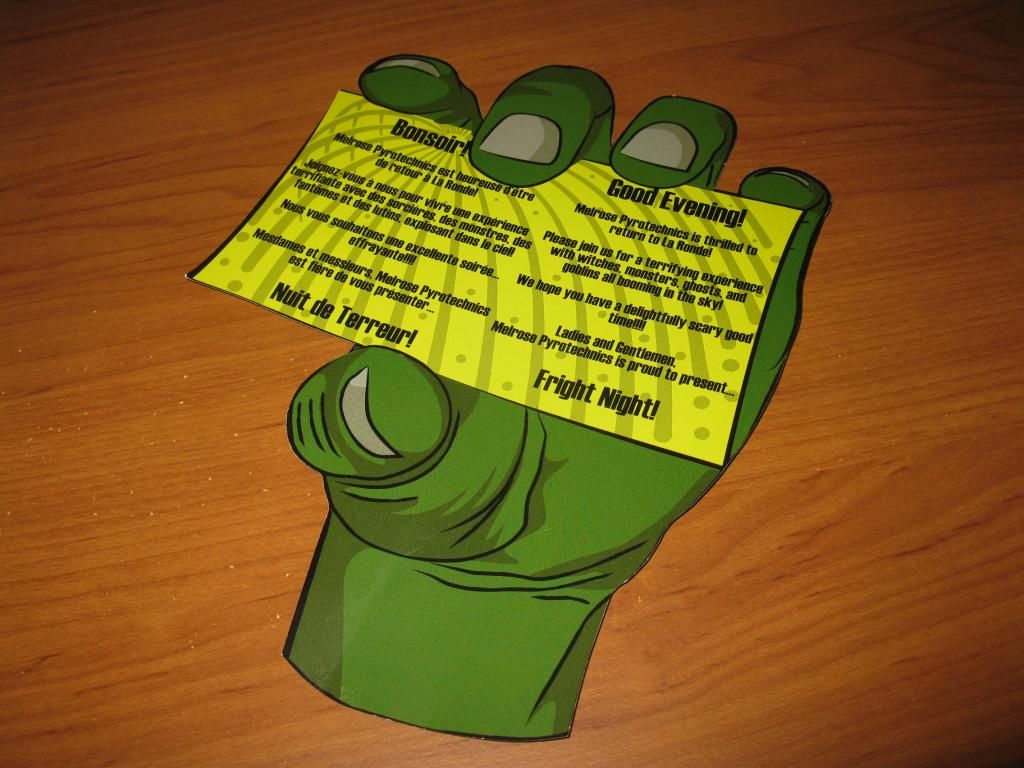Here are more comments on the Melrose's show, which was the 270th display in the history of the Montreal International Fireworks Competition. That team being winner of Gold Jupiter in 2006 and Bronze Jupiter in 2009, that was an anticipated display, especially as the
Fright Night is an original way to explore a broad repertoire of musics, and to add in some special and thrilling effects. It is also funny that, thanks to a photo published on her Facebook account during the Halloween season, competition director Martyne Gagnon was the
muse of the designers!
As we entered into the grandstands, we were offered a green hand-shaped cardboard featuring the Fright Night theme, the "fingers" holding, on the reverse side, a drawn information card introducing the show. However, in opposition to the
Reel Love cardboard designed in 2009, it didn't present the soundtrack listing.

The show opened dramatically on the well-known music of Michael Jackson's
Thriller, with a line of red flares, white flashes synchronized on thunder, and red horsetails, followed by shells of white comets and red stars. The audience became immediately vocal when that song began. Then, the red horsetails were back. Candles of meteor-headed comets erupted, augmented with shells of farfalles. Then, shells of white comets and red stars were back, and so on for the remaining of that segment. Similar repetitive patterns occurred during several parts of the show. Later, on the music of "People are strange", we saw volleys and volleys of smiley-face shells. During another segment, shells of double-farfalle and shells making clusters of crackling stars were exhibited in the same way.
More interesting patterns appeared during the show, like some very fast sequences of comets and tourbillons shot from the perimeter of the 4th ramp. On the music of "In the Hall of the Mountain King", the 5th ramp (made of seven floating platforms) came into life with green and purple flares, followed by various patterns of gerbs of the same colours, then augmented by fast and powerful sequences of green and purple mines on ramps 3 and 5. Later, meteor-headed comets moved along cables installed on the third ramp. The penultimate segment featured massive fans shooting interesting patterns of mines and/or comets. There was also a sort of rainbow effect on the music of "Wizard of Oz", but only with a partial set of colours.
Nonetheless, the technical and pyromusical design of other participants of this 30th edition were superior to this one. As I described, the design was often "simple" (while a such statement is unfair given the amount of time and energy required to set up a such display) and repetitive. As soon as the opening segment, I detected this problem and many subsequent segments confirmed this early assessment. The range of products was more limited than in other displays, and pyrotechnic effects were often limited to one level at a time. The
Thriller segment of the Swedish display in 2010, while shorter, was much more complex and dramatic. In the same way, Grupo Luso Pirotécnia (Portugal) used more evocative pyrotechnic devices for the
Ghostbusters part of their show in 2008.
The soundtrack was well-done, while I don't really understand why
Thriller was heard twice. I would have expected a particular twist for that. The narrative wasn't too obtrusive, but it didn't bring anything to the show. All designers should note that the competition master of ceremony inform the audience about the theme before the display, so any narrative of this sort is a duplication.
Unfortunately for Melrose, with three on-competition shows displayed before this one, I can already say that
Fright Night will not be in my personal Top 3. It could have been different in previous years, but with the level of the competition so far, I would be very surprised to see Melrose on the podium this year.
Fred
